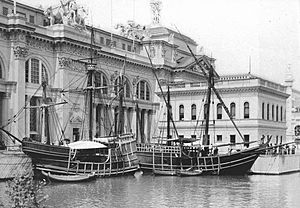Niña facts for kids

The Niña was one of the three famous ships Christopher Columbus sailed across the Atlantic Ocean in 1492. This journey led to Europeans discovering the Americas. The other two ships on this historic voyage were the Pinta and the Santa Maria. The Niña was a smaller, faster ship known as a caravel, which was perfect for exploration.
Contents
What Was the Niña?
The Niña was a type of ship called a caravel. Caravels were popular in the 15th century for their speed and ability to sail against the wind. They had special sails called lateen sails, which were triangular. These sails made the Niña very agile and easy to steer. The ship was originally named Santa Clara, but sailors often called it Niña after its owner, Juan Niño.
The Niña's Size and Crew
The Niña was the smallest of Columbus's three ships. It was about 60 to 70 feet (18 to 21 meters) long. It had a crew of around 24 to 26 sailors. Even though it was small, it was strong enough to cross the vast ocean. Life on board was cramped, but the crew worked together to keep the ship sailing.
Columbus's First Voyage
In 1492, Christopher Columbus set sail from Palos de la Frontera, Spain. His goal was to find a new sea route to Asia by sailing west. He believed the world was round and that he could reach the East Indies this way. The Niña, Pinta, and Santa María were the ships he used for this daring journey.
The Journey Across the Atlantic
The voyage was long and challenging. The ships sailed for many weeks without seeing land. The crew faced storms and uncertainty. On October 12, 1492, land was finally sighted. This land was an island in the Bahamas, which Columbus named San Salvador. This moment marked the beginning of European exploration and settlement in the Americas.
The Niña's Role in Discovery
After reaching the Bahamas, the ships explored other islands, including Cuba and Hispaniola. The Niña was often used for scouting because of its speed. It helped Columbus explore the coastlines and find new places. The Niña proved to be a very reliable ship throughout the expedition.
Return to Spain
On Christmas Eve, 1492, the Santa María ran aground and was wrecked off the coast of Hispaniola. This left only the Niña and the Pinta for the return journey. Columbus decided to sail back to Spain on the Niña. The Pinta, captained by Martín Alonso Pinzón, became separated from the Niña during a storm.
The Niña's Safe Return
The Niña faced a severe storm on its way back to Spain. Despite the rough seas, the sturdy caravel survived. Columbus and the Niña finally arrived back in Palos, Spain, on March 15, 1493. This completed the first successful voyage across the Atlantic. The Niña's safe return showed how well-built these ships were.
The Niña's Later Voyages
The Niña did not stop sailing after its first famous journey. It made several more trips across the Atlantic. It was part of Columbus's second expedition in 1493, which involved a much larger fleet of ships. During this trip, the Niña explored more islands in the Caribbean Sea.
The Niña's Final Fate
The exact fate of the Niña is not fully known. It is believed to have continued sailing for several years after Columbus's voyages. Records show it was used for trade and other expeditions. The last mention of the Niña in historical documents is around 1500. It likely continued to serve as a merchant ship until it was no longer seaworthy.
Images for kids
See also
 In Spanish: La Niña para niños
In Spanish: La Niña para niños


